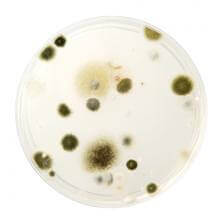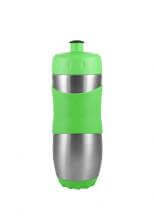Mold and Your Health
Can mold on foods or containers harm you? What’s the best way to remove mold?
Monica Reinagel, MS, LD/N, CNS
Listen
Mold and Your Health

Today’s show was inspired by an email from Niki, who wrote:
“No matter how hard I try, I can’t stop a thin film of black mold from growing inside my sports water bottle. I take it apart and let it dry after every use and scrub it about once a month yet the mold always shows up in the hard to reach places. Is this type of mold bad for me and how much of it is safe to ingest?”
The quick answer to Niki’s question is: “Eewww!” But here’s a more complete answer on mold and your health.
What is Mold?
Mold is a kind of fungus, a special class of microscopic living organisms that are neither plant nor animal, nor even bacteria. Other types of fungi include mushrooms, yeast, and truffles—many of which are not only edible but delicious.
See also: Are Mushrooms Good For You?
There are lots of different kinds of mold—up to 100,000 unique types. The vast majority are harmless. Some molds, such as the types used to grow penicillin or to make certain gourmet cheeses, are beneficial. But there are a few kinds of mold—fewer than a hundred—which are toxic. The problem with the mold on your water bottle is that we don’t really know what type it is.
Mold tends to grow in dark, damp environments. Even though they are microscopic, if you get enough mold spores in one place, they become visible to the human eye. Which means that by the time you see a thin black film on your mouthpiece, there are a lot of spores present. Chances are good that the molds growing on your sport bottle are some of the harmless ones—but why take a chance?
It’s not that hard to keep mold from sprouting on your sport bottles, although you will need to start cleaning them more than once a month. I’d recommend cleaning your reusable water bottles after every couple of uses—because mold isn’t the only concern. You’re also introducing bacteria to the mouthpiece every time you use it. You can also transfer viruses to your water bottle. All of these little critters love wet environments, which means that they will all be there waiting for you next time you take a drink. Why would you want to let that party go on for a month before you shut it down?
How to Clean Reusable Water Bottles

Swirl it around and let the water sit in the bottle while you do something else for a minute or two. Then squeeze some of the solution through the mouthpiece. Finally, pour off any remaining water and let your bottle air dry, propping the bottle up so it drains. Don’t rinse the diluted bleach solution off. Any remaining chlorine (and bleach smell) should dissipate with exposure to the air. If you want, you can give the bottle a quick rinse before refilling.
See also: Does Bottled Water Expire?
Is it Safe to Eat Mold on Food?
As I pointed out, there are many kinds of edible molds, including the ones responsible for some of the world’s most delicious cheeses. But these are very specific strains of mold. If you find “freelance” mold growing on food, it’s best to discard it. In particular, discard bread, soft cheese (such as cottage or ricotta), dairy products, or leftovers with any indications of mold. Even if it’s only a spot or two on the surface, it has probably contaminated the entire container.
If you find some small spots of mold on a large block of hard cheese, such as gouda, cheddar, or parmesan, it’s OK to cut off the mold and save the rest. Just be sure to cut a 1-inch margin around any visible mold and wash the knife thoroughly before reusing it.
See also: Cheese and Diet Tips
Keep in Touch
Thanks, Niki, for your question. If you have a suggestion for a future show topic or would like to find out about having me speak at your conference or event, send an email to nutrition@quickanddirtytips.comcreate new email. You can also post comments and questions on my Nutrition Diva Facebook Page. I answer a lot of listener questions in my free weekly newsletter, so if you’ve sent a question my way, be sure you’re signed up to receive that.
Mold in a Petri Dish and Water Bottle images from Shutterstock

